Nyctophobia - Visual Accessibility Analysis
Are you afraid of the dark? Nyctophobia is a unique game where sighted players get to experience what it is like to play a board game blind.
A review copy was provided by Pandasaurus Games in exchange for an honest analysis
Introduction
Nyctophobia is a tactile maze game designed by Catherine Stippel. She designed this game to play it with her blind uncle, so the visual accessibility was extremely important from the early stages of the development of this game.
I see Nyctophobia frequently mentioned on Reddit threads whenever someone asks for board game recommendations to play with a blind friend, or whenever the topic of playing board games as a blind individual comes up. In this post, I’ll take a look at the visual accessibility of a game that turns a disability into a game mechanic. Furthermore, another interesting thing about this game is that sighted players get to taste the challenges of playing a board game without relying on their eyesight,
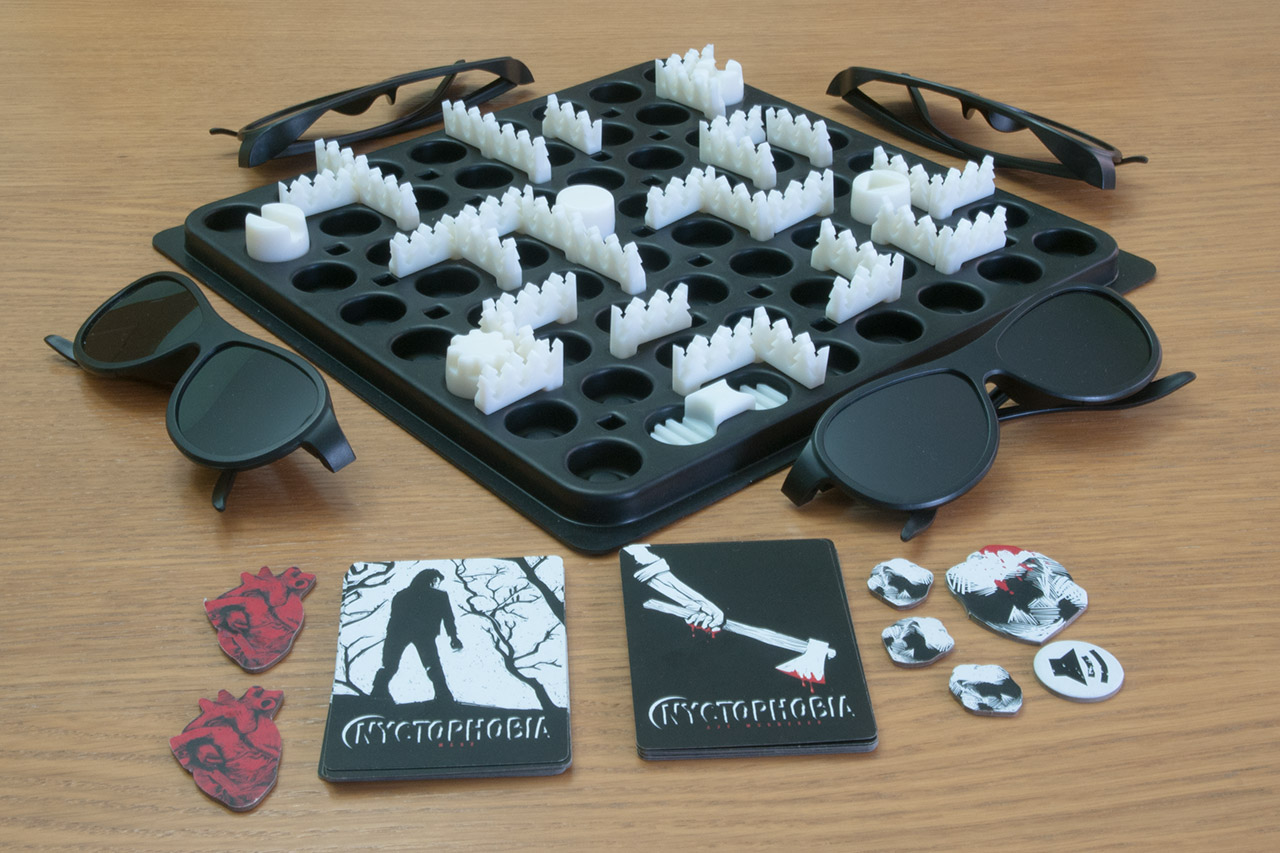 Image showing the game components
Image showing the game components
Game Overview
-
Game name: Nyctophobia
-
Publisher: Pandasaurus Games
-
Player count: 3-5
-
Playing time: 30-45 minutes
Before we start, I would like to clarify that the version analyzed in this post is the retail one. You can also fins a Target exclusive version titled Nyctophobia: Vampire Encounter.
Nyctophobia is set in a dark forest where the players, also known as the hunted, are trying to navigate a maze created by the hunter that is hot on their heels… with an axe! Up to four players can become one of several B-horror movie characters while one player gets to become the hunter that is practically the game master.
The hunter’s winning objective is to hunt down and kill one of the hunted before they call the police. On the other hand, the hunted win if one of them manages to find their car and call for help.
Once the players decide who becomes the hunter, the rest of the group chooses a character at random and receives two health tokens plus one stone token. After every hunted player chooses their unique player piece and reads the special ability of their character, they put on dark glasses which makes them sightless. Fun, huh?
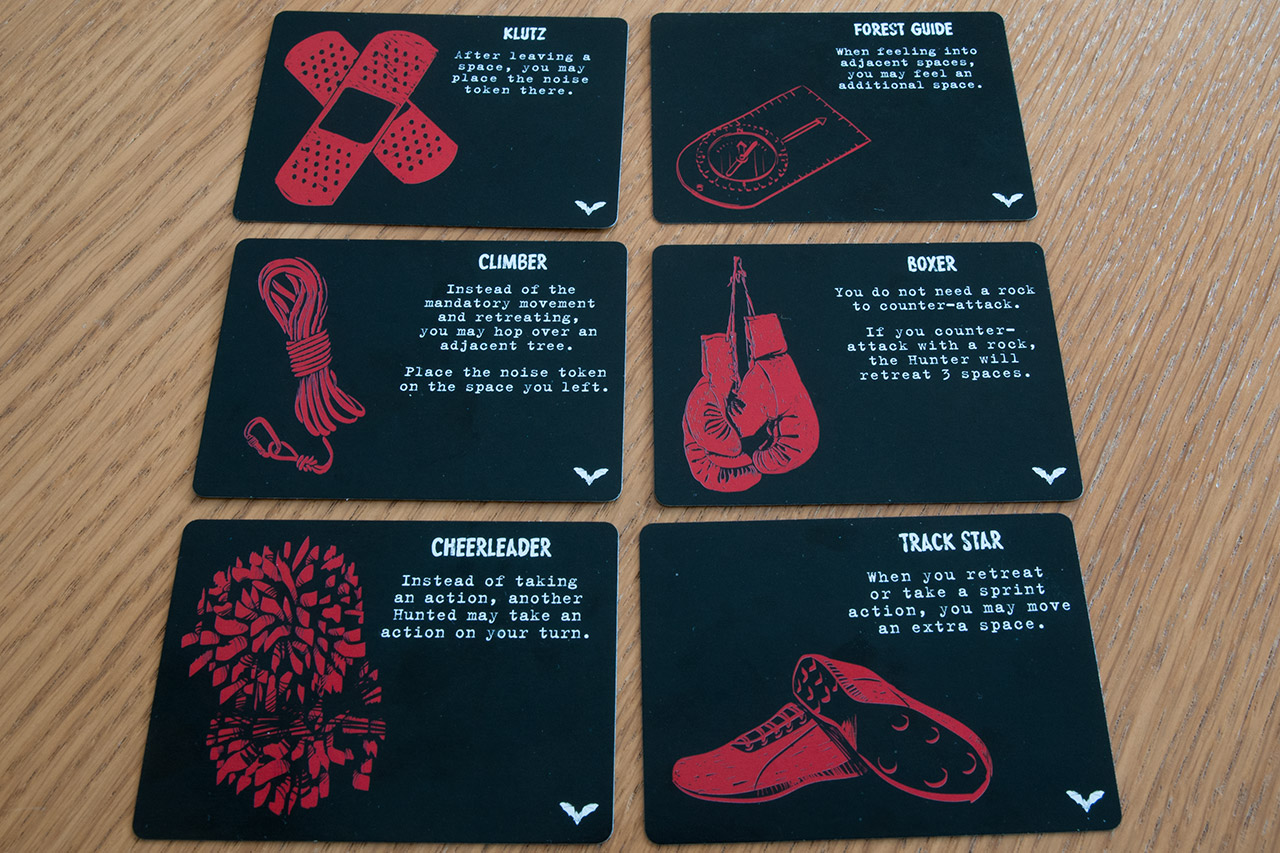 Image showing hunted characters
Image showing hunted characters
The hunter gets to choose whether they will play the axe murderer or the mage. Each character comes with their own deck of action cards. Next, they use the plastic trees to form a maze on the board. They also need to put the car somewhere in the map which occupies two adjacent spots, followed by placing stone tokens that the hunted can pick up somewhere on the map. Finally, they choose starting locations for each player. For the first few games, you can use one of the few example maps found in the rulebook.
Setting up the board usually takes no more than 5 minutes and then it is chop chop time! The hunter needs to follow strict movement rules. They always use the shortest path to move towards the player that is closest to them, unless that player is hiding or there is a noise token somewhere on the map. The hunter also has to play an action card on their turn. These cards can help them remove obstacles, help with their movement, or simply mess with the players by rotating the board, swapping the locations of two players, and other similar shenanigans.
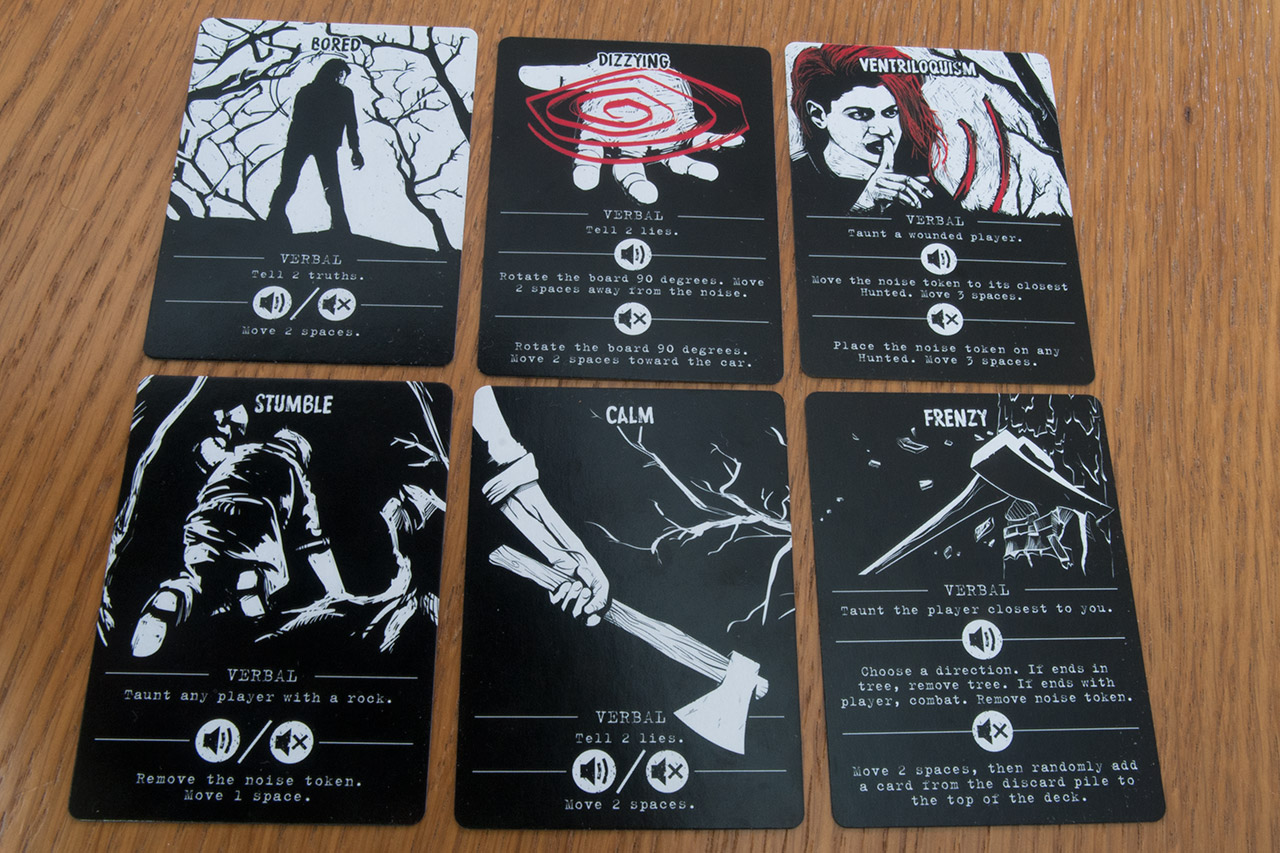 Image showing hunter action cards
Image showing hunter action cards
On a player’s turn, the hunter is in charge of placing the player’s fingers on their game piece. They can then scan their surroundings using their fingers and choose a direction to move. The hunted can also throw a stone at a certain direction and the hunter tells them how many spots the stone travels before hitting an object or person. They can also sprint in a given direction, which essentially grants them an extra move; or, they can hide by flipping their game piece upside down if they think the hunter is nearby.
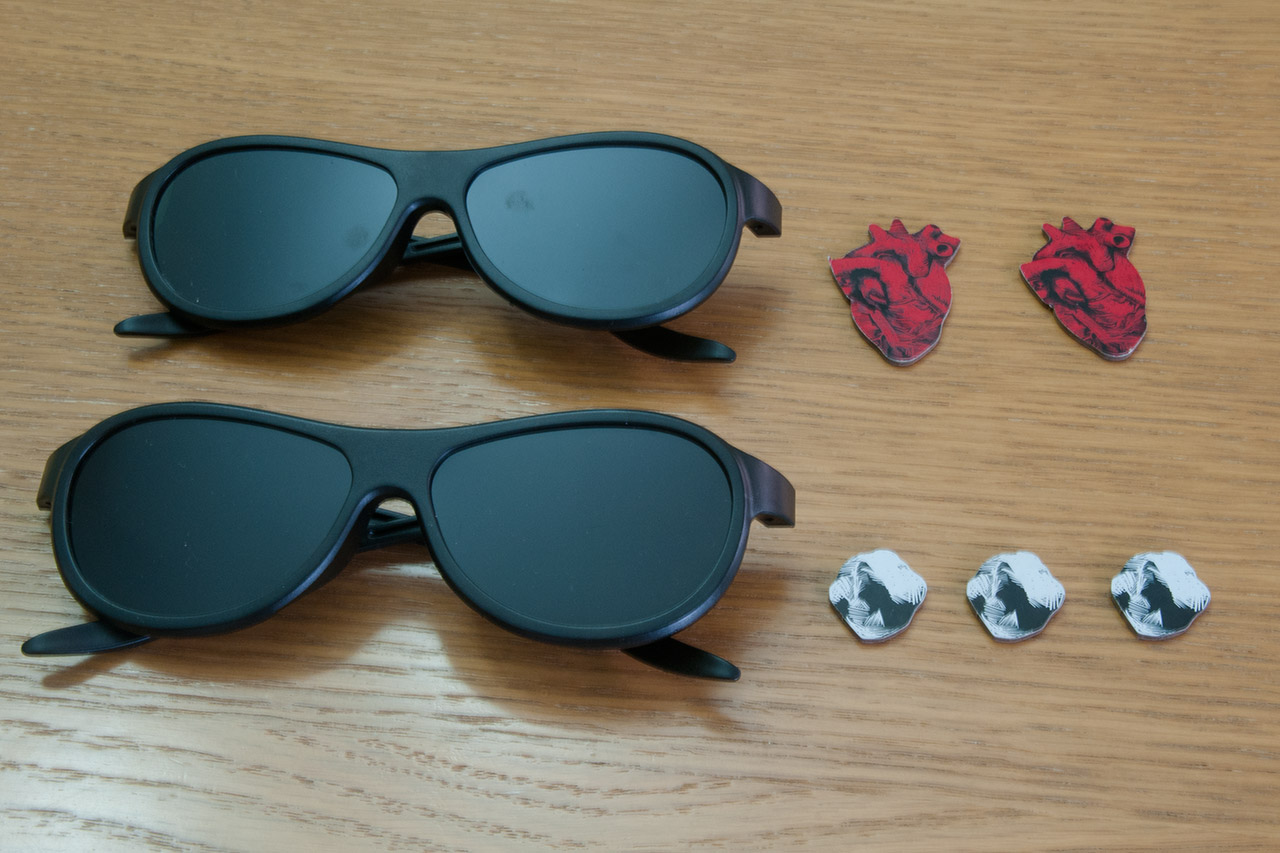 Image showing glasses, health and stone tokens
Image showing glasses, health and stone tokens
When a player throws a stone, if it hits the hunter, they knock the hunter back a couple of spaces and also wound them, limiting the hunter’s movement abilities on their next turn. If the stone hits a tree, the car, or the edge of the board, a noise token is placed on the spot where the stone lands. The hunter is now distracted and has to move towards the noise before moving to a nearby player. Finally, if a player hits another player with a stone, the wounded player loses a health token, and their painful screams result in the noise token being placed on top of them. This is why my family banned me from throwing the TV remote :(
One final important aspect of the game is the combat. When the hunter is right next to a player, combat begins and the player loses a health token. The player can counter-attack if they have a stone or retreat and hide. A counter-attack knocks the hunter back and also wounds them. If the player loses their last health token, the hunter wins the game.
Nyctophobia is as fun as the hunter makes it to be. The instruction manual and the hunter action cards encourage role-playing as well as noting that the hunter should play suboptimally and sometimes make moves that will result in hilarious moments. Think of the hunter as a cat, and the hunted as mice. Cats play with their prey before eventually delivering the killing blow. You should do that, too! What makes Nyctophobia fun is not winning the game, but seeing how lost people can be once you take away something they previously took for granted.
When playing as the hunted, it is very important to explain what you have in your surroundings to the rest of the group so they can get a sense of which part of the map you are located in. Distracting the hunter by making noise is also very useful to force them to move away from the hunted players. Sometimes you can hide even though you know the hunter is not near you, and intentionally speak to cause the noise token to be placed on your character to save another player.
“Over here, sucker!” - yelled Jimmy shortly before an axe chopped his arm off! On second thought, if there’s one thing I’ve learned from slasher movies, it’s not to taunt the lunatic coming after you. Feel free to ignore my advice and abandon your mates!
Visual Accessibility
Now that you have a general idea how the game plays, let’s talk about the interesting design choices that make this one of the most visually accessible games out there.
Components
First, when you open the game box, your attention will be instantly drawn to the largest component in the game, the 8x8 plastic board representing the forest. Since you need to navigate the forest by touch alone, it has one more dimension, depth. The board has 64 spaces where the game pieces move and on the edges of the spaces there are holes for the plastic trees that you will use to build a maze.
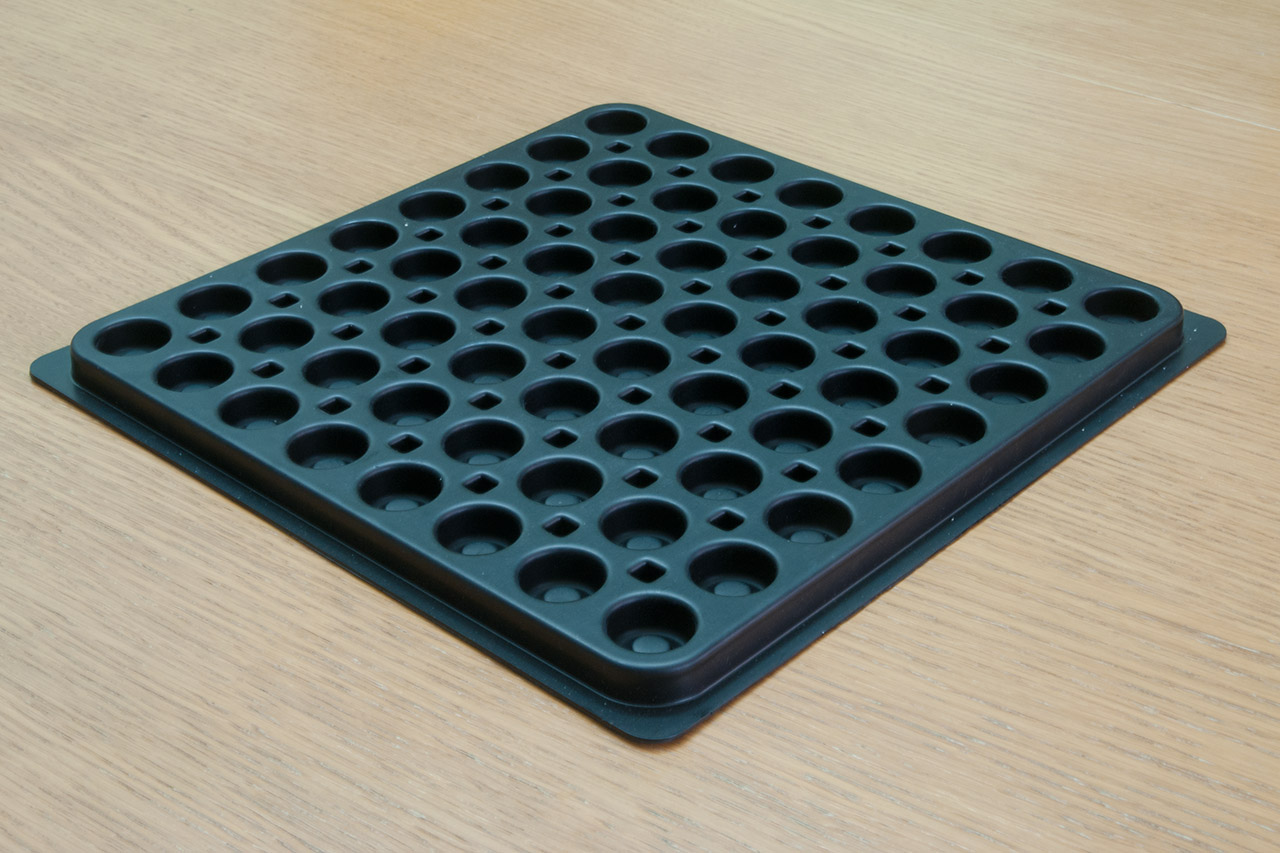 Image showing game board
Image showing game board
The rest of the plastic components that go on the board are all white. These are the player pieces, the car, and the trees. Because of this black and white color choice, the contrast of the pieces on the board is great. I’ll talk about the issues of having a blind hunter below, but having good contrast is really helpful for partially sighted players who want to play as the hunter. If you have a dark colored table and a partially sighted hunter, it would be a good idea to use a light colored table cover under the board so that the partially sighted hunter can easily see the edges of the game board.
There are a total of 5 player pieces and all of them have unique shapes on top and bottom which you can immediately identify. If there’s a textbook about component shapes to improve visual accessibility, these pieces should be an example on how it should be done. The car is also easily identifiable by touch especially since it is the only piece that occupies two spaces on the board. Finally, there are approximately 40 trees that you use to build the paths for the maze. They are placed on the raised edges of each movement spot to create a fence and they are high enough so that you do not accidentally touch the other side of the fence when scanning your area before you move your player piece.
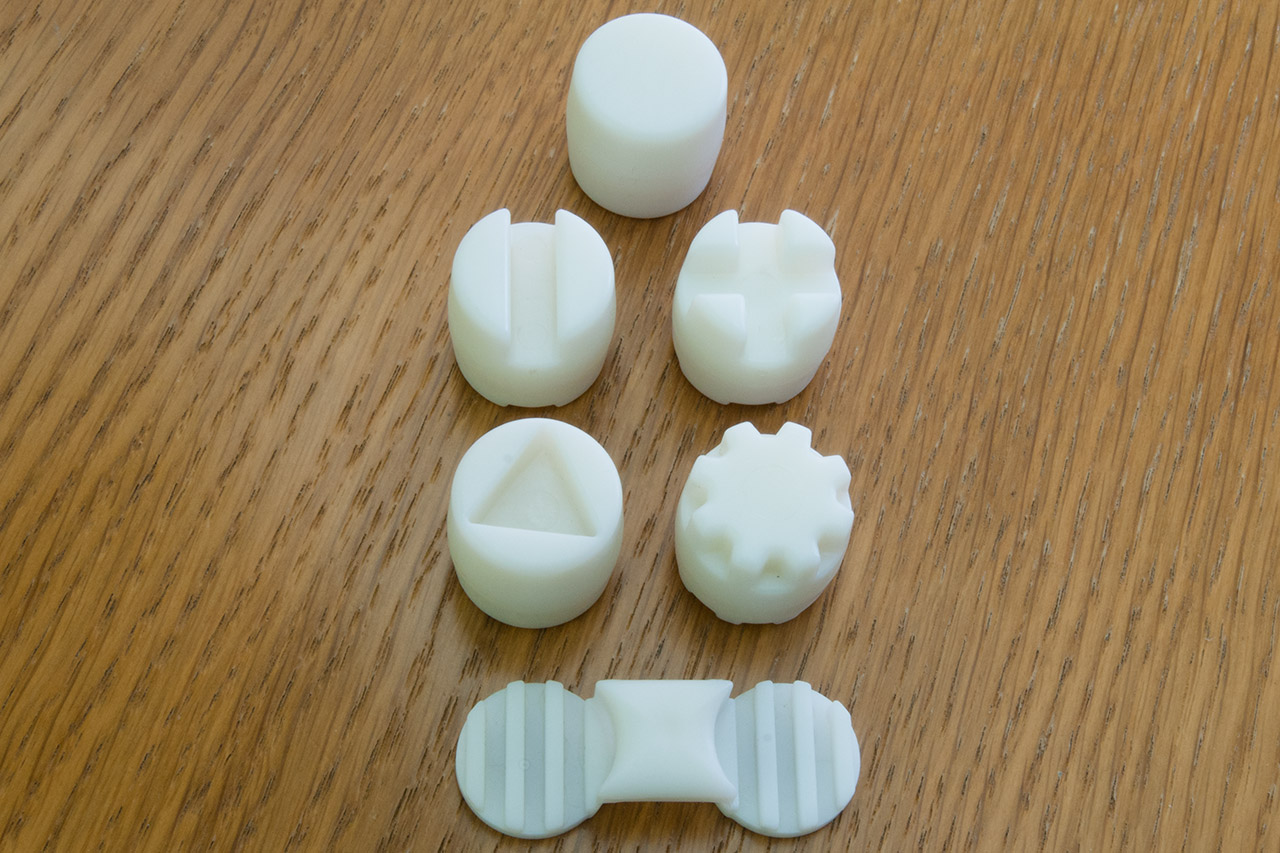 Image showing player pieces and car
Image showing player pieces and car
Besides the plastic pieces, you also get cardboard tokens used to track player health, stones, a single noise token, and a wound token for the hunter. Each token type has a distinct shape and is easily identifiable.
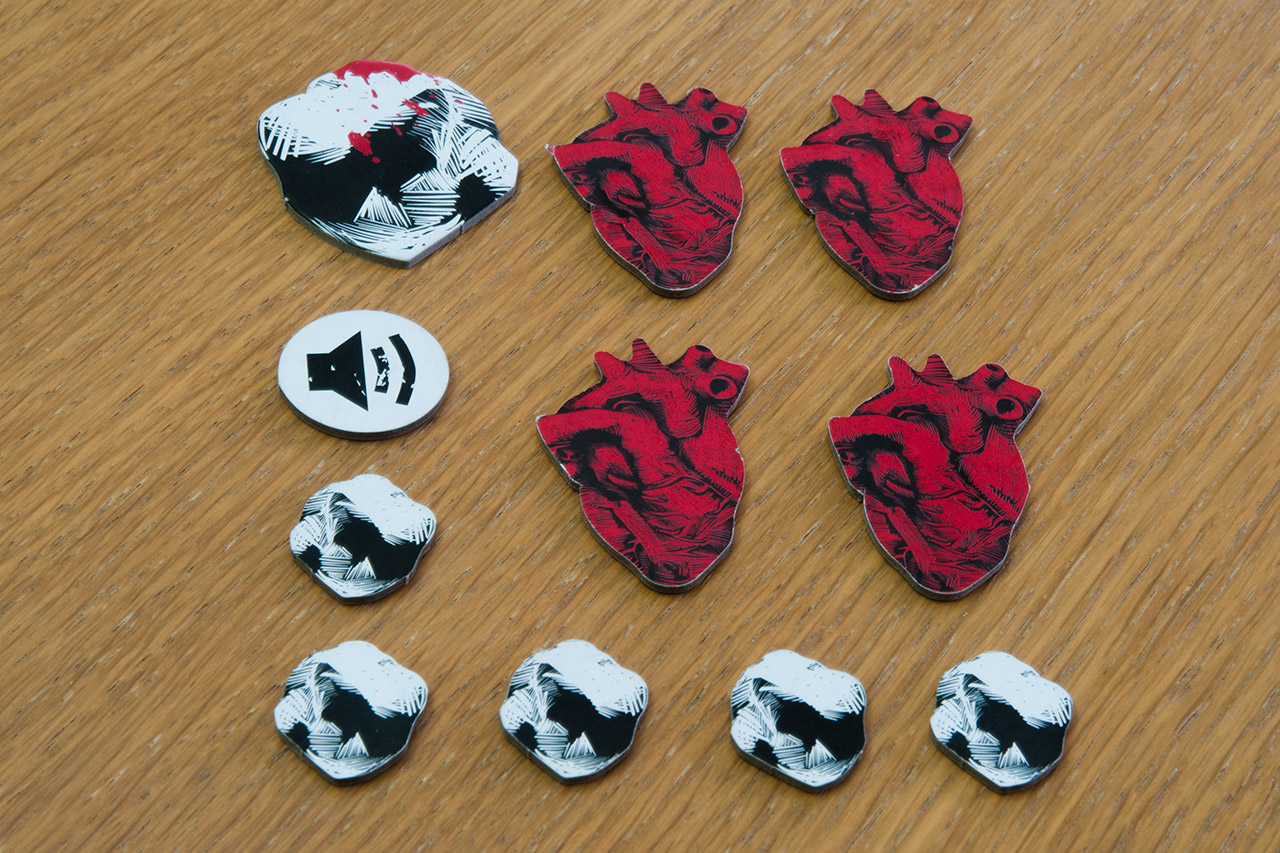 Image showing health, stone, noise and hunter wound tokens
Image showing health, stone, noise and hunter wound tokens
The cards in this game, just like in many other games that have a private hand of cards, present the largest problem. Having light text on a dark background for most cards provides decent contrast, however the art on the cards sometimes interferes with the text making it harder to read. I also tried using Seeing AI, an optical character recognition app on my phone, but even though it detects the text, the stylized font usually causes incorrect or partial text to be recognized. The good news here is that there are only 12 cards in the hunter deck. Because there are two hunter variants, you will essentially need to mark a total of 24 cards if you do not have the sight to read the text on the cards but can see well enough to absorb the information on the board.
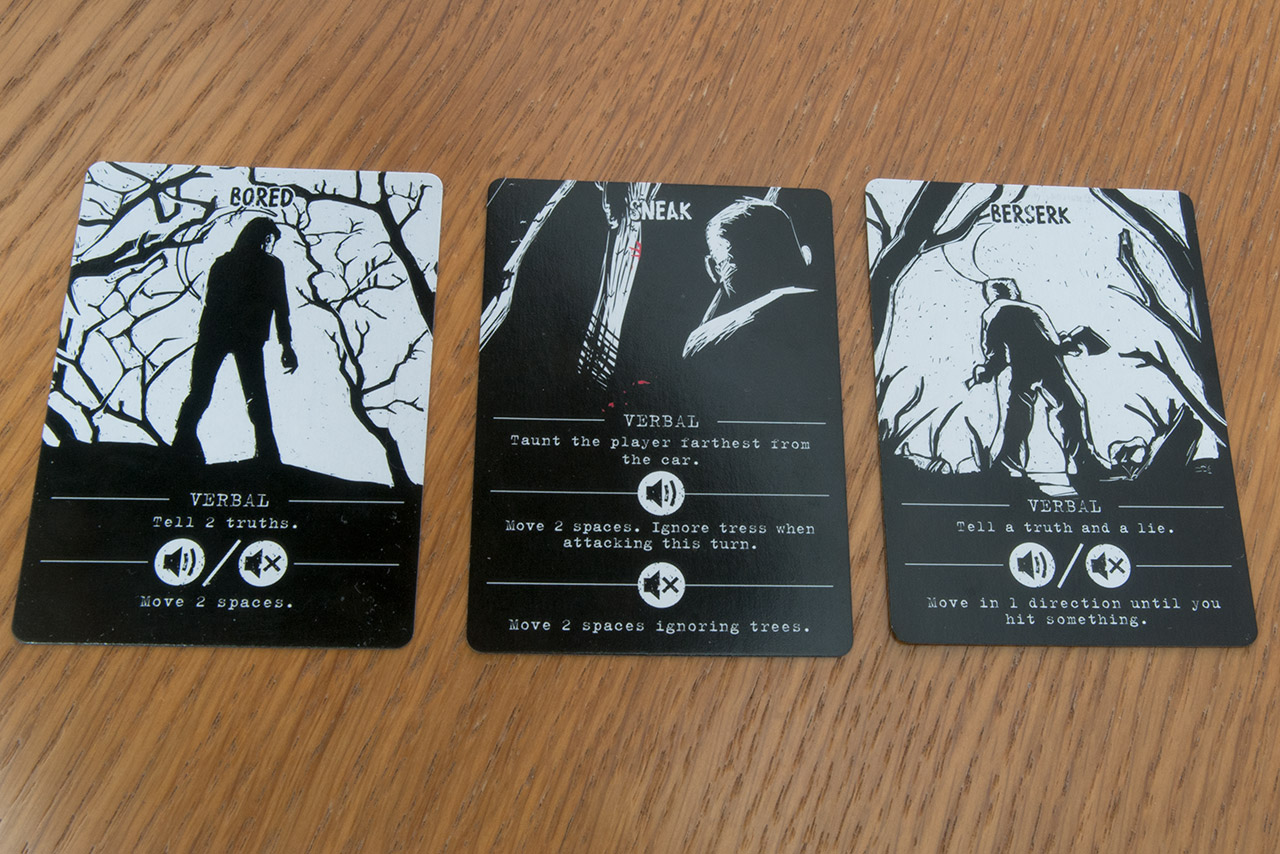 Image showing hunter action cards
Image showing hunter action cards
Blind Hunter
Cards are a common visual accessibility issue, but there’s a solution for that with some type of marking, either stickers or Braille. So, if we consider that a blind hunter has figured out a way to identify the cards in their hand, we have a perfectly accessible board game. Unfortunately, even though every component can be easily identified by touch, that does not mean the game is enjoyable to play as the hunter.
The first problem would be in creating the maze itself. The example mazes in the rulebook can’t be used. Now, this can be solved by having a sighted person assign coordinates and create a list of locations for the trees and game pieces for each map that the blind hunter can then go through using a screen reader to create the maze. Of course, the hunter could create their own maze, but personally I found that to be a difficult task to complete at a reasonable amount of time. You don’t want to block a player or or car completely as that can break the game.
From the start, the initial setup time is increased. Extended game time when playing with a blind player is very common, but it still has to be within reason as the goal of playing a board game is to have fun. Sitting idly waiting for the hunter isn’t very amusing, especially since you cannot use the time to plan your next move like in other games because you have no idea what the maze looks like before exploring it.
When the blind hunter needs to take an action by playing a card, most cards are conditional. So, the hunter needs to have plenty of information about the board on who is located where and what the distance between certain objects is. Sure, this information can be acquired by touching the board and counting spaces, but, at least for me, not in a reasonable amount of time to keep the game entertaining.
Entertaining and fun gameplay for the hunter comes from the fact that they can see the silly things the hunted players do. When you remove the hunter’s ability to see, most of the fun is lost.
To summariize, playing as a blind hunter is absolutely possible thanks to the highly accessible components, however the most interesting parts in playing the hunter come from their ability to see what happens on the board.
Conclusion
Nyctophobia will test your coordination, memory, communication skilils, and most importantly if you are a sighted player, it will provide a glimpse to what it is like to play board games blind. This is a team game, so you have to pay attention to figure out where your friends are and which parts of the map they’ve searched for the car. When you try to focus on what everyone is doing, you will realize how hard it is to remember simple things like what your last position was on your previous turn.
This is one of those rare games that can be played by a fully blind individual without having to modify the components or rely on significant sighted assistance during the game. All of this is because of the distinct components with easily identifiable shapes and sizes.
Playing as a blind hunter could work, however, based on my own experience, it may not be enjoyable, both for the hunter and the rest of the group due to the extended game time and downtime on the hunter’s turn. Is it worth picking up the game if you can only play as a hunted character? Absolutely. The game is tons of fun with a good hunter that aims to make the experience funny or creepy.
I hope after playing this game, sighted players will play other games with a new perspective as they get to appreciate the value of accessible game components. Other game designers and publishers should take notes, especially from the cardboard tokens, as they are most commonly used in a variety of games, yet when trying to represent different types of items, the only distinct thing on the tokens is either the color or text, but not the shape or size.
Leave a comment